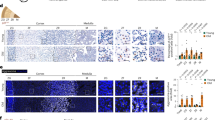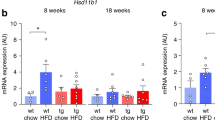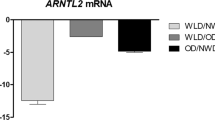Abstract
Background/objectives:
Obesity is a major risk factor for the development of type 2 diabetes and other debilitating diseases. Obesity and diabetes are intimately linked with altered levels of adrenal steroids. Elevated levels of these hormones induce insulin resistance and cause cardiovascular diseases. The mechanisms underlying obesity-related alterations in adrenal steroids are still not well understood. Here, we investigated how diet-induced obesity affects the morphology and function of the mouse adrenal cortex.
Methods:
We fed animals either a high-fat diet (HFD) or a normal diet (60% kcal from fat or 10% kcal from fat, respectively) for 18 weeks. We then assessed various aspects of adrenal gland morphology and function, as well as basal plasma concentrations of steroid hormones and ACTH.
Results:
We show that adrenal glands of mice fed a HFD release more corticosterone and aldosterone, resulting in higher plasma levels. This increase is driven by adrenal cortical hyperplasia, and by increased expression of multiple genes involved in steroidogenesis. We demonstrate that diet-induced obesity elevates Sonic hedgehog signaling in Gli1-positive progenitors, which populate the adrenal capsule and give rise to the steroidogenic cells of the adrenal cortex. Feeding animals with a HFD depletes Gli1-positive progenitors, as the adrenal cortex expands.
Conclusions:
This work provides insight into how diet-induced obesity changes the biology of the adrenal gland. The association of these changes with increased Shh signaling suggests possible therapeutic strategies for obesity-related steroid hormone dysfunction.
This is a preview of subscription content, access via your institution
Access options
Subscribe to this journal
Receive 12 print issues and online access
$259.00 per year
only $21.58 per issue
Buy this article
- Purchase on Springer Link
- Instant access to full article PDF
Prices may be subject to local taxes which are calculated during checkout





Similar content being viewed by others
References
Kopelman PG . Obesity as a medical problem. Nature 2000; 404: 635–643.
King B, Jiang Y, Su X, Xu J, Xie L, Standard J et al. Weight control, endocrine hormones and cancer prevention. Exp Biol Med (Maywood) 2013; 238: 502–508.
Krug AW, Ehrhart-Bornstein M . Adrenocortical dysfunction in obesity and the metabolic syndrome. Horm Metab Res 2008; 40: 515–517.
Pasquali R, Vicennati V, Gambineri A . Adrenal and gonadal function in obesity. J Endocrinol Invest 2002; 25: 893–898.
Qi D, Rodrigues B . Glucocorticoids produce whole body insulin resistance with changes in cardiac metabolism. Am J Physiol Endocrinol Metab 2007; 292: E654–E667.
Sowers JR, Whaley-Connell A, Epstein M . Narrative review: the emerging clinical implications of the role of aldosterone in the metabolic syndrome and resistant hypertension. Ann Intern Med 2009; 150: 776–783.
Pasquali R, Vicennati V . Activity of the hypothalamic-pituitary-adrenal axis in different obesity phenotypes. Int J Obes Relat Metab Disord 2000; 24: S47–S49.
Pasquali R, Vicennati V, Cacciari M, Pagotto U . The hypothalamic-pituitary-adrenal axis activity in obesity and the metabolic syndrome. Ann NY Acad Sci 2006; 1083: 111–128.
Glass AR, Burman KD, Dahms WT, Boehm TM . Endocrine function in human obesity. Metab Clin Exp 1981; 30: 89–104.
Muller-Fielitz H, Lau M, Johren O, Stellmacher F, Schwaninger M, Raasch W . Blood pressure response to angiotensin II is enhanced in obese Zucker rats and is attributed to an aldosterone-dependent mechanism. Br J Pharmacol 2012; 166: 2417–2429.
Livingstone DE, Jones GC, Smith K, Jamieson PM, Andrew R, Kenyon CJ et al. Understanding the role of glucocorticoids in obesity: tissue-specific alterations of corticosterone metabolism in obese Zucker rats. Endocrinology 2000; 141: 560–563.
Naeser P . Function of the adrenal cortex in obese-hyperglycemic mice (gene symbol ob). Diabetologia 1974; 10: 449–453.
Northcott CA, Fink GD, Garver H, Haywood JR, Laimon-Thomson EL, McClain JL et al. The development of hypertension and hyperaldosteronism in a rodent model of life-long obesity. Endocrinology 2012; 153: 1764–1773.
Fraulob JC, Ogg-Diamantino R, Fernandes-Santos C, Aguila MB, Mandarim-de-Lacerda CA . A mouse model of metabolic syndrome: insulin resistance, fatty liver and non-alcoholic fatty pancreas disease (NAFPD) in C57BL/6 mice fed a high fat diet. J Clin Biochem Nutr 2010; 46: 212–223.
Roberge C, Carpentier AC, Langlois MF, Baillargeon JP, Ardilouze JL, Maheux P et al. Adrenocortical dysregulation as a major player in insulin resistance and onset of obesity. Am J Physiol Endocrinol Metab 2007; 293: E1465–E1478.
Thomson SP, Stump CS, Kurukulasuriya LR, Sowers JR . Adrenal steroids and the metabolic syndrome. Curr Hypertens Rep 2007; 9: 512–519.
Cassano AE, White JR, Penraat KA, Wilson CD, Rasmussen S, Karatsoreos IN . Anatomic, hematologic, and biochemical features of C57BL/6NCrl mice maintained on chronic oral corticosterone. Comp Med 2012; 62: 348–360.
Bornstein SR, Engeland WC, Ehrhart-Bornstein M, Herman JP . Dissociation of ACTH and glucocorticoids. Trends Endocrinol Metab 2008; 19: 175–180.
Willenberg HS, Schinner S, Ansurudeen I . New mechanisms to control aldosterone synthesis. Horm Metab Res Metab 2008; 40: 435–441.
Wang M . The role of glucocorticoid action in the pathophysiology of the Metabolic Syndrome. Nutr Metab 2005; 2: 3.
Lamounier-Zepter V, Ehrhart-Bornstein M, Bornstein SR . Metabolic syndrome and the endocrine stress system. Horm Metab Res 2006; 38: 437–441.
Wolkersdorfer GW, Bornstein SR . Tissue remodelling in the adrenal gland. Biochem Pharmacol 1998; 56: 163–171.
Huang CC, Miyagawa S, Matsumaru D, Parker KL, Yao HH . Progenitor cell expansion and organ size of mouse adrenal is regulated by sonic hedgehog. Endocrinology 2010; 151: 1119–1128.
King P, Paul A, Laufer E . Shh signaling regulates adrenocortical development and identifies progenitors of steroidogenic lineages. Proc Natl Acad Sci USA 2009; 106: 21185–21190.
Ching S, Vilain E . Targeted disruption of Sonic Hedgehog in the mouse adrenal leads to adrenocortical hypoplasia. Genesis 2009; 47: 628–637.
Wood MA, Acharya A, Finco I, Swonger JM, Elston MJ, Tallquist MD et al. Fetal adrenal capsular cells serve as progenitor cells for steroidogenic and stromal adrenocortical cell lineages in M. musculus. Development 2013; 140: 4522–4532.
Laufer E, Kesper D, Vortkamp A, King P . Sonic hedgehog signaling during adrenal development. Mol Cell Endocrinol 2012; 351: 19–27.
Guasti L, Cavlan D, Cogger K, Banu Z, Shakur A, Latif S et al. Dlk1 upregulates Gli1 expression in male rat adrenal capsule cells through the activation of beta1 integrin and ERK1-2. Endocrinology 2013; 154: 4675–4684.
McGinnis R, Walker J, Margules D, Aird F, Redei E . Dysregulation of the hypothalamus-pituitary-adrenal axis in male and female, genetically obese (ob/ob) mice. J Neuroendocrinol 1992; 4: 765–771.
Naeser P . In vitro release of corticosteroids from adrenal glands of obese-hyperglycemic mice (gene symbol ob). Acta Physiol Scand 1974; 92: 175–180.
Bornstein SR, Uhlmann K, Haidan A, Ehrhart-Bornstein M, Scherbaum WA . Evidence for a novel peripheral action of leptin as a metabolic signal to the adrenal gland: leptin inhibits cortisol release directly. Diabetes 1997; 46: 1235–1238.
Kruse M, Bornstein SR, Uhlmann K, Paeth G, Scherbaum WA . Leptin down-regulates the steroid producing system in the adrenal. Endocr Res 1998; 24: 587–590.
Buettner R, Scholmerich J, Bollheimer LC . High-fat diets: modeling the metabolic disorders of human obesity in rodents. Obesity 2007; 15: 798–808.
Hinchliffe E, Carter S, Owen LJ, Keevil BG . Quantitation of aldosterone in human plasma by ultra high performance liquid chromatography tandem mass spectrometry. J Chromatogr B Anal Technol Biomed Life Sci 2013; 913–914: 19–23.
Schindelin J, Arganda-Carreras I, Frise E, Kaynig V, Longair M, Pietzsch T et al. Fiji: an open-source platform for biological-image analysis. Nat Methods 2012; 9: 676–682.
Kamentsky L, Jones TR, Fraser A, Bray MA, Logan DJ, Madden KL et al. Improved structure, function and compatibility for CellProfiler: modular high-throughput image analysis software. Bioinformatics 2011; 27: 1179–1180.
Miller WL, Auchus RJ . The molecular biology, biochemistry, and physiology of human steroidogenesis and its disorders. Endocr Rev 2011; 32: 81–151.
Lightman SL, Conway-Campbell BL . The crucial role of pulsatile activity of the HPA axis for continuous dynamic equilibration. Nat Rev Neurosci 2010; 11: 710–718.
Beuschlein F, Fassnacht M, Klink A, Allolio B, Reincke M . ACTH-receptor expression, regulation and role in adrenocortial tumor formation. Eur J Endocrinol 2001; 144: 199–206.
Wood MA, Hammer GD . Adrenocortical stem and progenitor cells: unifying model of two proposed origins. Mol Cell Endocrinol 2011; 336: 206–212.
Klop B, Elte JW, Cabezas MC . Dyslipidemia in obesity: mechanisms and potential targets. Nutrients 2013; 5: 1218–1240.
Palm W, Swierczynska MM, Kumari V, Ehrhart-Bornstein M, Bornstein SR, Eaton S . Secretion and signaling activities of lipoprotein-associated hedgehog and non-sterol-modified hedgehog in flies and mammals. PLoS Biology 2013; 11: e1001505.
Nachtergaele S, Mydock LK, Krishnan K, Rammohan J, Schlesinger PH, Covey DF et al. Oxysterols are allosteric activators of the oncoprotein Smoothened. Nat Chem Biol 2012; 8: 211–220.
Khaliullina H, Panakova D, Eugster C, Riedel F, Carvalho M, Eaton S . Patched regulates Smoothened trafficking using lipoprotein-derived lipids. Development 2009; 136: 4111–4121.
Bijlsma MF, Spek CA, Zivkovic D, van de Water S, Rezaee F, Peppelenbosch MP . Repression of smoothened by patched-dependent (pro-)vitamin D3 secretion. PLoS Biol 2006; 4: e232.
Khaliullina H, Bilgin M, Sampaio JL, Shevchenko A, Eaton S . Lipoproteins carry endocannabinoids that inhibit the Hedgehog pathway. bioRxiv 2013; doi:10.1101/000570.
Di Marzo V . The endocannabinoid system in obesity and type 2 diabetes. Diabetologia 2008; 51: 1356–1367.
Sewer MB, Dammer EB, Jagarlapudi S . Transcriptional regulation of adrenocortical steroidogenic gene expression. Drug Metab Rev 2007; 39: 371–388.
Schinner S, Willenberg HS, Krause D, Schott M, Lamounier-Zepter V, Krug AW et al. Adipocyte-derived products induce the transcription of the StAR promoter and stimulate aldosterone and cortisol secretion from adrenocortical cells through the Wnt-signaling pathway. Int J Obes 2007; 31: 864–870.
Krug AW, Vleugels K, Schinner S, Lamounier-Zepter V, Ziegler CG, Bornstein SR et al. Human adipocytes induce an ERK1/2 MAP kinases-mediated upregulation of steroidogenic acute regulatory protein (StAR) and an angiotensin II-sensitization in human adrenocortical cells. Int J Obes 2007; 31: 1605–1616.
Ehrhart-Bornstein M, Lamounier-Zepter V, Schraven A, Langenbach J, Willenberg HS, Barthel A et al. Human adipocytes secrete mineralocorticoid-releasing factors. Proc Natl Acad Sci USA 2003; 100: 14211–14216.
Lavoie HA, King SR . Transcriptional regulation of steroidogenic genes: STARD1, CYP11A1 and HSD3B. Exp Biol Med (Maywood) 2009; 234: 880–907.
Calle EE, Kaaks R . Overweight, obesity and cancer: epidemiological evidence and proposed mechanisms. Nat Rev Cancer 2004; 4: 579–591.
Acknowledgements
We gratefully acknowledge Celso Gomez-Sanchez, Ken Morohashi and Peter King for providing antibodies. We are grateful to Marc Bickle from the Technology Development Studio (MPI-CBG), for designing and implementing pipelines for the image analysis. We thank Julia Jarrels and Britta Schilling from the DNA Microarray Facility (MPI-CBG) for their assistance in real-time quantitative PCR analyses. We acknowledge Biomedical Services (MPI-CBG) for their help in animal husbandry and handling. We are grateful to Susann Malik for technical assistance. This work was supported by DFG grant, KFO 252.
Author information
Authors and Affiliations
Corresponding author
Ethics declarations
Competing interests
The authors declare no conflict of interest.
Additional information
Supplementary Information accompanies this paper on International Journal of Obesity website
Supplementary information
Rights and permissions
About this article
Cite this article
Swierczynska, M., Mateska, I., Peitzsch, M. et al. Changes in morphology and function of adrenal cortex in mice fed a high-fat diet. Int J Obes 39, 321–330 (2015). https://doi.org/10.1038/ijo.2014.102
Received:
Revised:
Accepted:
Published:
Issue Date:
DOI: https://doi.org/10.1038/ijo.2014.102
This article is cited by
-
The effects of 20-hydroxyecdysone on nuclear shape, heterochromatin quantity and gray-level co-occurrence matrix texture analysis of adrenal zona fasciculata cells in an obese gerbil (Gerbillus tarabuli) model for metabolic syndrome: a correlational study
Histochemistry and Cell Biology (2023)
-
Restricted cafeteria feeding and treadmill exercise improved body composition, metabolic profile and exploratory behavior in obese male rats
Scientific Reports (2022)
-
The dysregulation of the hypothalamic–pituitary–adrenal axis in diet-induced prediabetic male Sprague Dawley rats
Nutrition & Metabolism (2020)
-
Obesity Might Persistently Increase Adrenal Gland Volume: a Preliminary Study
Obesity Surgery (2020)
-
The adrenal gland microenvironment in health, disease and during regeneration
Hormones (2017)



